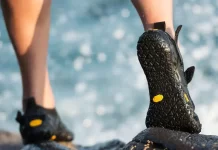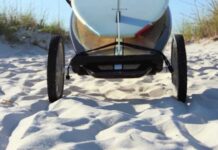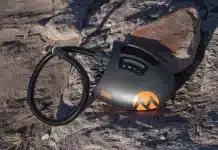Are you curious about the perfect paddle blade shape for your flat water SUP adventures? Look no further! This article will explore different paddle blade shapes and reveal which works best for smooth, serene paddling on calm waters.
Whether you’re a seasoned paddler or just starting, understanding the ideal blade shape can significantly enhance your performance and overall experience on the SUP board. So, grab your board, and let’s dive into the world of paddle blade shapes for flat water paddling!
Blade Shape
When choosing the right SUP paddle for flat water paddling, the blade shape is one of the most important factors to consider. The design of the paddle blade can significantly impact your performance on the water, so it’s essential to understand the options available and their respective advantages and disadvantages.
Design
Paddle blades generally come in two main designs: symmetrical and asymmetrical. Each design has its unique characteristics and can significantly influence your paddling experience.
Surface Area
The surface area of a paddle blade refers to the size of the blade itself. Blades with larger surface areas are generally better suited for powerful strokes and are ideal for paddlers looking to cover longer distances. Conversely, blades with smaller surface areas are more accessible to maneuver and provide better control in more technical situations.
Scoop
The scoop of a paddle blade refers to the curvature of the blade face. Blades with a more pronounced scoop tend to have better catches in the water, allowing for more efficient strokes. On the other hand, blades with a flatter scoop may provide a more subtle entry into the water, which can be advantageous in calmer conditions.
Blade Angle
The blade angle refers to the orientation of the blade face relative to the paddle shaft. A blade with a higher angle will require less effort to lift out of the water, making it easier and less fatiguing to paddle over long distances. Conversely, a blade with a lower angle will provide more power per stroke but may require more effort to lift out of the water.
Design
As mentioned earlier, paddle blades can be symmetrical or asymmetrical in design.
Symmetrical
Symmetrical paddle blades have the same shape on both sides, with a consistent curve and profile. This design offers a balanced feel in the water and provides equal power and control regardless of which side of the blade is engaged.
Overview
Symmetrical blades are popular for flat water paddling due to their versatility and ease of use. The consistent shape allows for a smooth, predictable stroke, making them ideal for beginners and recreational paddlers. They provide a stable and efficient stroke, ensuring a comfortable paddling experience.
Advantages
One of the main advantages of symmetrical blades is their ease of use. Since they have the same shape on both sides, there is no need to worry about blade orientation, making them great for beginners. They also provide equal power and control, regardless of which side of the blade is engaged. Additionally, symmetrical blades offer a balanced feel in the water, resulting in a smooth and comfortable stroke.
Disadvantages
While symmetrical blades offer many advantages, they do have some limitations. One of the main disadvantages is their limited ability to generate maximum power. The consistent shape of the blade may result in a more moderate power output compared to asymmetrical blades. Additionally, symmetrical blades may not have the same efficiency in catching the water, especially if you are looking for quick bursts of speed or need to generate maximum power for racing or surfing.
Asymmetrical
Unlike symmetrical blades, asymmetrical paddle blades have a distinct shape with a more pronounced curve on one side and a flatter profile on the other. This design is intended to optimize the efficiency and power of the stroke by providing a better catch in the water.
Overview
Asymmetrical blades are designed to maximize the efficiency and power of each stroke. The curved face of the blade allows for a more aggressive catch, providing increased power and speed. The flatter back face of the blade reduces resistance during the recovery phase of the stroke, resulting in a smoother and more efficient paddling experience.
Advantages
The main advantage of asymmetrical blades is their ability to generate maximum power and speed. The pronounced curve on one side of the blade allows for a more aggressive catch, capturing more water with each stroke. This translates into increased power and speed, making asymmetrical blades popular among competitive paddlers and those looking for a high-performance paddle. Additionally, the flatter back face of the blade reduces resistance during the recovery phase, resulting in a smoother and more efficient stroke.
Disadvantages
While asymmetrical blades offer many advantages, they may not suit all paddlers or conditions. The pronounced curve on one side of the blade means it must be correctly oriented in the water for optimal performance. This can require more attention to blade positioning and technique, which may be challenging for beginners or less experienced paddlers. Additionally, asymmetrical blades may require more effort to control and maneuver in technical situations, making them better suited for open water or racing rather than tight and confined spaces.
In conclusion, when choosing a SUP paddle blade shape for flat water paddling, you must consider your specific needs and paddling style. Symmetrical blades offer easy to use and a balanced feel in the water, making them ideal for beginners and recreational paddlers.
On the other hand, asymmetrical blades provide maximum power and speed, making them an excellent choice for competitive paddlers or those looking for a high-performance paddle. Assess your skill level, paddling goals, and the conditions you’ll be paddling in to determine which blade shape will work best for you. Happy paddling!





































